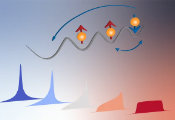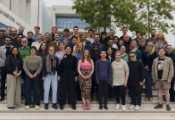TU Researchers Develop New Method for a Better Understanding of Quantum Mechanical Systems
July 24, 2025 - A research team led by TU Darmstadt has transformed a difficult problem in quantum physics into a much simpler version through innovative reformulation – without losing any important information. The scientists have thus developed a new method for better understanding and predicting difficult quantum mechanical systems.
This problem has long preoccupied quantum physics: how can systems consisting of many atoms, between which strong attractive forces act, be described mathematically? Already for about ten particles, such systems are at the limits of current numerical methods.
It becomes particularly complicated when the atoms are exposed to an external force. However, this is the case in many experiments with cold atoms due to the way in which motion is often restricted to one dimension, for example. Such systems of strongly interacting particles in one dimension were proposed in the 1960s and have since served as a reference problem in theoretical physics. So far, they have only been solved in a few special cases.
Here, the researchers attempted to simplify a system using a so-called effective theory – that is, by considering only the ‘important’ physical aspects. Since atoms form pairs (diatoms) due to their strong attraction, the scientists attempted to find an ‘effective’ description based on atoms and diatoms instead of the many atoms. This reduces the number of particles to be described and thus simplifies the description.
The approach is now additionally based on the fact that atoms and diatoms belong to two classes of particles, known as fermions and bosons. In a so-called duality transformation, the roles of fermions and bosons were swapped: here, the forces between atoms and diatoms are now weak, which means that the problem can now be solved more easily using special solution methods for weak interactions.
Combination of both methods
With their approach, the research team combined both methods: effective theories to isolate the physically relevant aspects and duality transformations to convert the complex problem into a simpler form that is easier to solve. With this fundamental research, the scientists solved a notoriously difficult problem in theoretical physics. The results allow predictions to be made for experiments with cold atoms and strong attractive forces in one dimension. Potentially, more complicated, higher-dimensional systems could also be treated in a similar way.
At TU Darmstadt, the research was led by Professor Hans-Werner Hammer's Strong Interactions and Ultracold Atoms group at the Institute of Nuclear Physics (Department of Physics). The first author is doctoral student Timothy G. Backert. Scientists from Massey University in New Zealand and Aarhus University in Denmark were also involved.




































